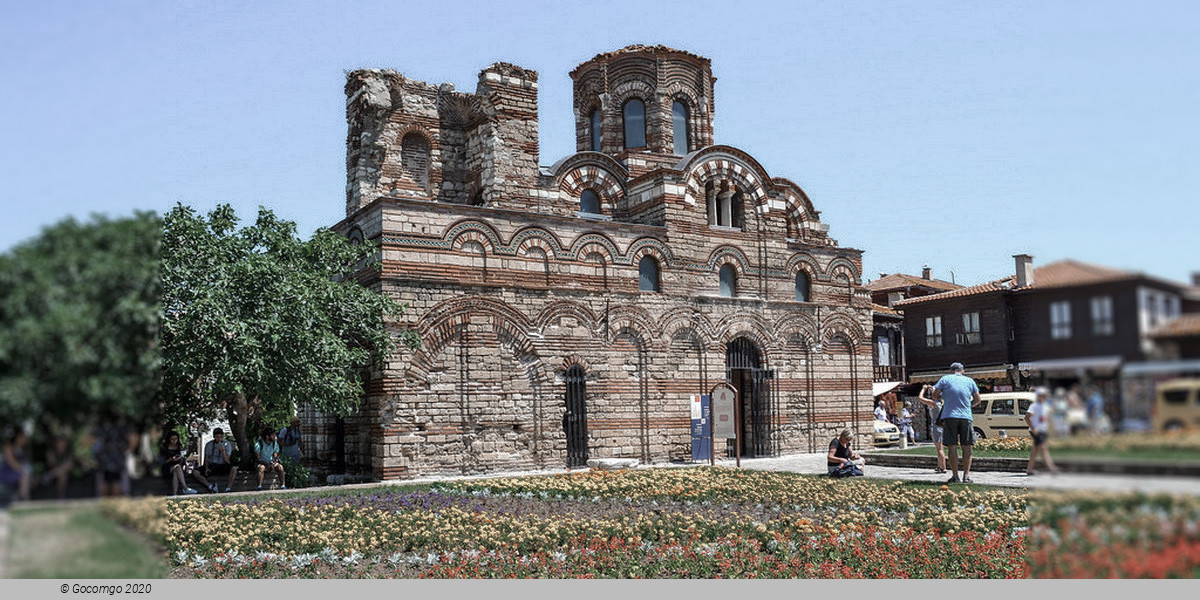Nessebar

Nessebar is an ancient city and one of the major seaside resorts on the Bulgarian Black Sea Coast, located in Burgas Province. It is the administrative center of the homonymous Nesebar Municipality. Often referred to as the "Pearl of the Black Sea", Nessebar is a rich city-museum defined by more than three millennia of ever-changing history. The small city exists in two parts separated by a narrow man-made isthmus with the ancient part of the settlement on the peninsula (previously an island), and the more modern section (i.e. hotels, later development) on the mainland side. The older part bears evidence of occupation by a variety of different civilizations over the course of its existence.
History
Bulgarian archaeologist Lyuba Ognenova-Marinova led six underwater archaeological expeditions for the Bulgarian Academy of Sciences (BAS) between 1961 and 1972 in the waters along the Bulgarian Black Sea Coast. Her work led to the identification of five chronological periods of urbanization on the peninsula surrounding Nesebar through the end of the second millennium B.C., which included the Thracian protopolis, the Greek colony Mesambria, a Roman-ruled village to the Early Christian Era, the Medieval settlement, and a Renaissance-era town, known as Mesembria or Nessebar.
Antiquity
Originally a Thracian settlement, known as Mesembria, the town became a Greek colony when settled by Dorians from Megara at the beginning of the 6th century BC, then known as Mesembria. It was an important trading center from then on and a rival of Apollonia (Sozopol). It remained the only Dorian colony along the Black Sea coast, as the rest were typical Ionian colonies. At 425-424 BC the town joined the Delian League, under the leadership of Athens.
Remains date mostly from the Hellenistic period and include the acropolis, a temple of Apollo, and an agora. A wall that formed part of the Thracian fortifications can still be seen on the north side of the peninsula.
Bronze and silver coins were minted in Mesembria since the 5th century BC and gold coins since the 3rd century BC. The town fell under Roman rule in 71 BC, yet continued to enjoy privileges such as the right to mint its own coinage.
Medieval era
It was one of the most important strongholds of the Eastern Roman Empire from the 5th century AD onwards and was fought over by Byzantines and Bulgars, being captured and incorporated in the lands of the First Bulgarian Empire in 812 by Khan Krum after a two-week siege only to be ceded back to Byzantium by Knyaz Boris I in 864 and reconquered by his son Tsar Simeon the Great. During the time of the Second Bulgarian Empire, it was also contested by Bulgarian and Byzantine forces and enjoyed particular prosperity under Bulgarian tsar Ivan Alexander (1331–1371) until it was conquered by Crusaders led by Amadeus VI, Count of Savoy in 1366. The Bulgarian version of the name, Nesebar or Mesebar, has been attested since the 11th century.
Monuments from the Middle Ages include the 5–6th century Stara Mitropoliya ("old bishopric"; also St Sophia), a basilica without a transept; the 6th-century church of the Virgin; and the 11th century Nova Mitropoliya ("new bishopric"; also St Stephen) which continued to be embellished until the 18th century. In the 13th and 14th century a remarkable series of churches were built: St Theodore, St Paraskeva, St Michael St Gabriel, and St John Aliturgetos.
Ottoman rule
The capture of the town by the Ottoman Empire in 1453 marked the start of its decline, but its architectural heritage remained and was enriched in the 19th century by the construction of wooden houses in a style typical for the Bulgarian Black Sea Coast during this period. In the early 19th century many locals joined the Pan-Orthodox organization sometimes wrongly called the Greek patriotic organization, Filiki Eteria, while at the outbreak of the Greek War of Independence (1821) part of the town's youth participated in the struggle under Alexandros Ypsilantis.
Nesebar was a kaza center in İslimye sanjak of Edirne Province before 1878.
Third Bulgarian state
After the Liberation of Bulgaria from Ottoman rule in 1878, Nesebar became part of the autonomous Ottoman province of Eastern Rumelia in Burgaz department until it united with the Principality of Bulgaria in 1885. Around the end of the 19th century, Nesebar was a small town of Greek fishermen and vinegrowers. In 1900 it had a population of approximately 1.900, of which 89% were Greeks, but it remained a relatively empty town. It developed as a key Bulgarian seaside resort since the beginning of the 20th century. After 1925 a new town part was built and the historic Old Town was restored.

